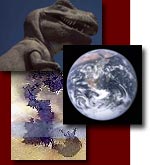| Site Map | Contacts | Links | Newsletter | |
The Bible and Science:
Dinosaur and Human Footprints
| Roland T. Bird in a 1939 article in Natural History (43:5.254-61) mentioned giant carved human footprints from Glen Rose, Texas. Clifford Burdick refusing to believe the prints were carved, searched and located the prints in 1945. In 1961 pictures of these tracks appeared in The Genesis Flood. In 1970 Stanley Taylor with a film crew dammed up the Paluxy River to produce the film Footprints in Stone which claimed dinosaur and human footprints are found together. |  |
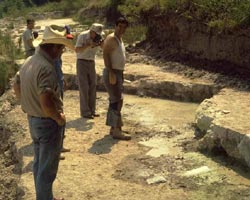 |
Carl Baugh (in a white T-shirt) started excavating of more prints in 1982, and set up a very small museum in the first apothecary shop in Texas which was moved because of disputes between Carl Baugh and the land owner over the ownership of the shop. |
| Dr. Arlton Murray went to Glen Rose, Texas to investigate the supposed dinosaur and human prints found by Carl Baugh. Other came to help Baugh remove rock layers to find prints. |  |
 |
Other prints were traced along the Paluxy River. Some water helps the prints stand out better. |
| Searching for footprints along the Paluxy River. | 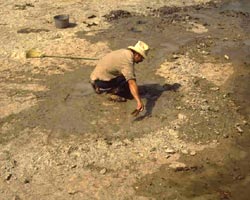 |
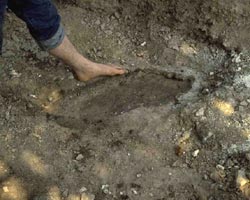 |
One of the prints found by Carl Baugh is claimed to be a giant human footprint. |
| The print is over 20 inches long and does not even look like a normal human footprint. |  |
 |
Dr. Arlton Murray was not convinced that this was a human foot print so he secretly made a mold of the print when Baugh was not there. Dr. Murray took the mold to an expert podiatrist in Texas who said that anatomically this was not a human footprint. |
| If the outer two toe prints of the Acrocanthosaurus are filled in, it will look somewhat like a human footprint. While Dr. Murray was there he met Glen Kuban who was studying the prints. |  |
 |
When these tracks were reexamined very closely by Glen Kuban and then by experts, they were found to be dinosaur tracks not human footprints. Erosion and back fill made some of them look human. |
 When the Taylor trail was followed the prints turned into clear dinosaur tracks. On other prints claw marks were seen (See Glen Kuban's excellent website The Paluxy Dinosaur/"Man Track" Controversy). Because of this evidence the film Footprints in Stone was removed from circulation. Dr. John Morris wrote Impact article 151 (1986) stating "none of the four trails at the Taylor site can be today regarded as unquestionably human." |
|
| Other prehistoric animals like mastodons were clearly around at the same time as man because arrows, spears and knife marks have been found on the bones, but none of this has been found with dinosaur bones. | 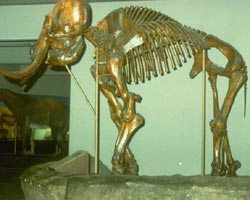 |
 |
The hammer in the rock, called the "London Artifact" is most likely a 19th century minerís hammer. Dr. Murray thinks the hammer was used to fix wagon wheels. About a dozen of these hammers have been found at Scott's Bluff, Nebraska. It is not Noah's hammer as Baugh claims. |
 Max Track
Max Track
Glen Kuban explains the tracks found in the Paluxy River in Texas.
There has been much false information given out by Carl Baugh (Creation Evidence Museum). The human footprint called The "Burdick Print" he bought is clearly a carving. For more information on this and other supposed human footprints see the CRSEF expedition that I attended. There are no clear human footprints in the Paluxy River except the ones that were carved which are anatomically wrong.
Carl Baugh's dinosaur claws are actually crocodile teeth. The supposed human tooth is a fish tooth. The supposed wood is iron oxide. The supposed human finger is most likely a burrow filling. The large skeleton is just 200-300 years old and not part of the Cretaceous layer.


Above is an iron cup encased in coal. It was found by Frank Kanard in 1912. The coal came from the Will Berton Coal Mine in Oklahoma. Carl Baugh claims it was made before or just after Noah's flood. The cup looks like one from the 19th century. There were no iron cups like this 5,000 years old. The iron age started about 1200 BC. The cup was probably dropped by a miner, became buried under coal, and then cemented together with water under pressure in a relatively short time. Nodules seem to easily form around objects. I was surprised to see how fast my son's bike had rusted after being left out in the rain. Other artifacts have been found in mines, but they were left by other miners, buried and then found (See Ancient Man: A Hankbook of Puzzling Artifacts by William R. Cross, 1978). Another example is the Coso artifact which turned out to be nothing more than a 1920's Champion spark plug (see The Coso Artifact Mystery from the Depths of Time).
Even Answers In Genesis questioned Carl Baugh's views (See web page What About Carl Baugh?) For more information see Creation/Evolution 15,&17 published by NCSE (See their website National Center for Science Education).
When I (Dr. Stephen C. Meyers) saw Carl Baugh's video of the excavation, I was very disappointed. The quality was very poor. One could not tell what he was excavating. The audio said Baugh was removing marl. Marl can easily be removed to form whatever shape one wants.
Dr. John Morris, president of the Institute for Creation Research wrote, "Another research project of some note involved the alleged discovery of human and dinosaur footprints in the Paluxy River, central Texas. Having been nominally involved since the late 1960's, 1 undertook a major role in 1975 from nearby Oklahoma, culminating in a summary book, Tracking Those Incredible Dinosaurs, and the People Who Knew Them, in 1980. This book was withdrawn in 1985 when further research called the original interpretation into question. Research continues, but I am of the opinion that the evidence is, at best, ambiguous and unusable as an anti-evolutionary argument at the present time." See http://www.icr.org/article/798/
There is now Dinosaur Valley State Park where one can see some of the best preserved dinosaur tracks in the United States, and the supposed human footprints. The park is located Northwest of Glen Rose, Texas.
See also Dinosaur Tracks and Ichnology.
